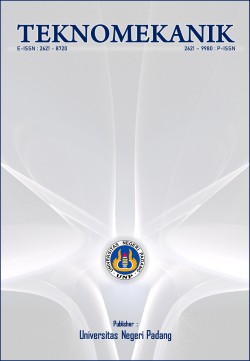Effect of PLTS power factor settings on power losses and voltage conditions in 20 kV medium voltage networks
DOI:
https://doi.org/10.24036/jptk.v6i2.32523Keywords:
PLTS Roof, Power factor, Losses, Voltage magnitudeAbstract
As technology develops, the rapid increase in PV capacity will affect the grid. This makes it important to determine the PV limit that can be injected into the grid defined as the PV Hosting Capacity (PVHC). In this paper, the author evaluates and analyses the impact of PV connections on medium voltage distribution lines (20kv) using ETAP 19.01 simulation. A medium voltage Grid with a capacity of 30MVA, has an industrial load varies from 650 kVA to 25 kVA with the total load capacity of 2225 KVA. The loads are supplied from two sources, grid and PV system. The simulation results state that the best of grid performance which provide the best losses and voltage condition when connecting 100% capacity of PV to the existing grid network is by setting the inverter power factor to 0.9. This setting will provide lowest power losses of 0,7 kW and improve the voltage value.
Downloads
References
Arshad, A., & Lehtonen, M. (2018). Instantaneous Active/Reactive Power Control Strategy for Flicker Mitigation Under High PV Penetration. IEEE PES Innovative Smart Grid Technologies Conference Europe (ISGT-Europe).
Bajagain, R., Bhattarai, N., & Subedi, T. R. (2020). Impact of Grid interconnected micro-hydro based mini-grid system on Local Distribution Grid: A Case study of Taplejung mini-grid, Nepal. International Journal of Engineering and Applied Sciences (IJEAS), 7(4). https://doi.org/10.31873/ijeas.7.04.09
Bollen, M. H. J., & Rönnberg, S. K. (2017). Hosting capacity of the power grid for renewable electricity production and new large consumption equipment. Energies, 10(9). https://doi.org/10.3390/en10091325
Darussalam, R., & Garniwa, I. (2018). The Effect of Photovoltaic Penetration on Frequency Response of Distribution System. International Conference on Sustainable Energy Engineering and Application (ICSEEA), 81–85.
de Parijós Junior, I. R., Galhardo, M. A. B., Costa, T. O., Pinho, J. T., Williamson, S., & Macêdo, W. N. (2023). Influence of photovoltaic microgeneration on the demand profile and its effects on the grid power quality. Electric Power Systems Research, 214. https://doi.org/10.1016/j.epsr.2022.108935
Ding, F., Mather, B., & Gotseff, P. (2016). Technologies to Increase PV Hosting Capacity in Distribution Feeders. IEEE Power and Energy Society General Meeting (PESGM), 1–5.
Esau, Z., Ryoichi, H., & Hiroyuki, K. (2023). A flexible stochastic PV hosting capacity framework considering network over-voltage tolerance. Energy Reports, 9, 529–538. https://doi.org/10.1016/j.egyr.2022.11.101
Esmaili, M., Firozjaee, E. C., & Shayanfar, H. A. (2014). Optimal placement of distributed generations considering voltage stability and power losses with observing voltage-related constraints. Applied Energy, 113, 1252–1260. https://doi.org/10.1016/j.apenergy.2013.09.004
Fatima, S., Püvi, V., Arshad, A., Pourakbari-Kasmaei, M., & Lehtonen, M. (2021). Comparison of economical and technical photovoltaic hosting capacity limits in distribution networks. Energies, 14(9). https://doi.org/10.3390/en14092405
Fatima, S., Püvi, V., & Lehtonen, M. (2021). Comparison of Different References When Assessing PV HC in Distribution Networks. Clean Technologies, 3(1), 123–137. https://doi.org/10.3390/cleantechnol3010008
Gusdhi, R. R., & Sudiarto, B. (2020). An analysis on the impacts of load types, load capacities installed and power generated by the inverter towards disturbance on an on-grid solar power plant. IOP Conference Series: Earth and Environmental Science, 599(1). https://doi.org/10.1088/1755-1315/599/1/012082
Hung, D. Q., Mithulananthan, N., & Bansal, R. C. (2013). Analytical strategies for renewable distributed generation integration considering energy loss minimization. Applied Energy, 105, 75–85. https://doi.org/10.1016/j.apenergy.2012.12.023
Juanuwattanakul, P., & Masoum, M. A. S. (2012). Increasing distributed generation penetration in multiphase distribution networks considering grid losses, maximum loading factor and bus voltage limits. IET Generation, Transmission and Distribution, 6(12), 1262–1271. https://doi.org/10.1049/iet-gtd.2011.0841
Kazemi-Robati, E., Sepasian, M. S., Hafezi, H., & Arasteh, H. (2022). PV-hosting-capacity enhancement and power-quality improvement through multiobjective reconfiguration of harmonic-polluted distribution systems. International Journal of Electrical Power and Energy Systems, 140. https://doi.org/10.1016/j.ijepes.2022.107972
Koutroumpezis, G. N., & Safigianni, A. S. (2010). Optimum allocation of the maximum possible distributed generation penetration in a distribution network. Electric Power Systems Research, 80(12), 1421–1427. https://doi.org/10.1016/j.epsr.2010.06.005
Kumar, M. (2020). Technical Issues and Performance Analysis for Grid Connected PV System and Present Solar Power Scenario. International Conference on Electrical and Electronics Engineering, 639–644.
Liu, X., Cramer, A. M., & Liao, Y. (2015). Reactive power control methods for photovoltaic inverters to mitigate short-term voltage magnitude fluctuations. Electric Power Systems Research, 127, 213–220. https://doi.org/10.1016/j.epsr.2015.06.003
Soleh, M., & Taryo, ). (n.d.). ANALISIS LOSSES JARINGAN DAN ALTERNATIF PERBAIKAN PADA PENYULANG JATIWANGI RAYON MAJALENGKA.
Torquato, R., Salles, D., Pereira, C. O., Meira, P. C. M., & Freitas, W. (2018). A Comprehensive Assessment of PV Hosting Capacity on Low-Voltage Distribution Systems. IEEE Transactions on Power Delivery, 33(2), 1002–1012. https://doi.org/10.1109/TPWRD.2018.2798707
Ul Abideen, M. Z., Ellabban, O., & Al-Fagih, L. (2020). A review of the tools and methods for distribution networks’ hosting capacity calculation. In Energies (Vol. 13, Issue 11). MDPI AG. https://doi.org/10.3390/en13112758
Downloads
Published
How to Cite
Issue
Section
License
Copyright (c) 2023 Resti Savira, Budi Sudiarto

This work is licensed under a Creative Commons Attribution 4.0 International License.





